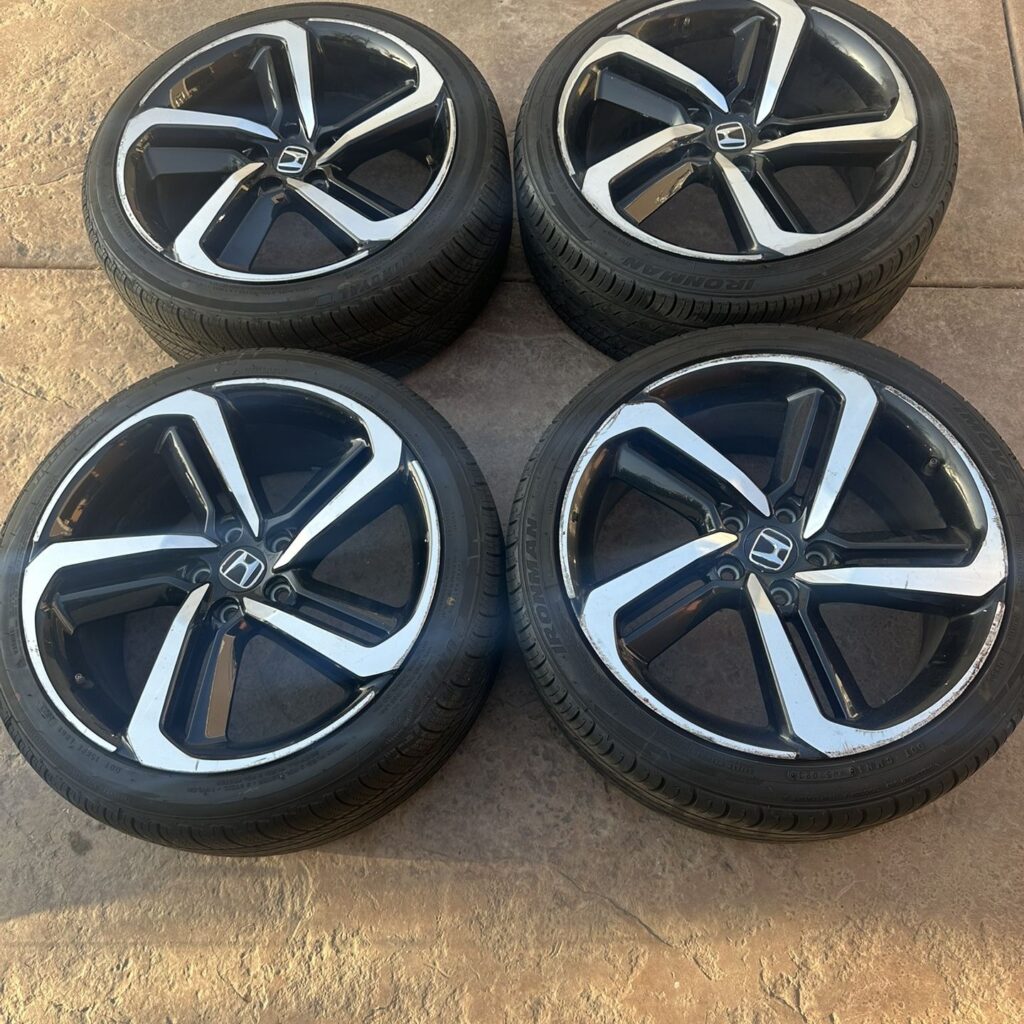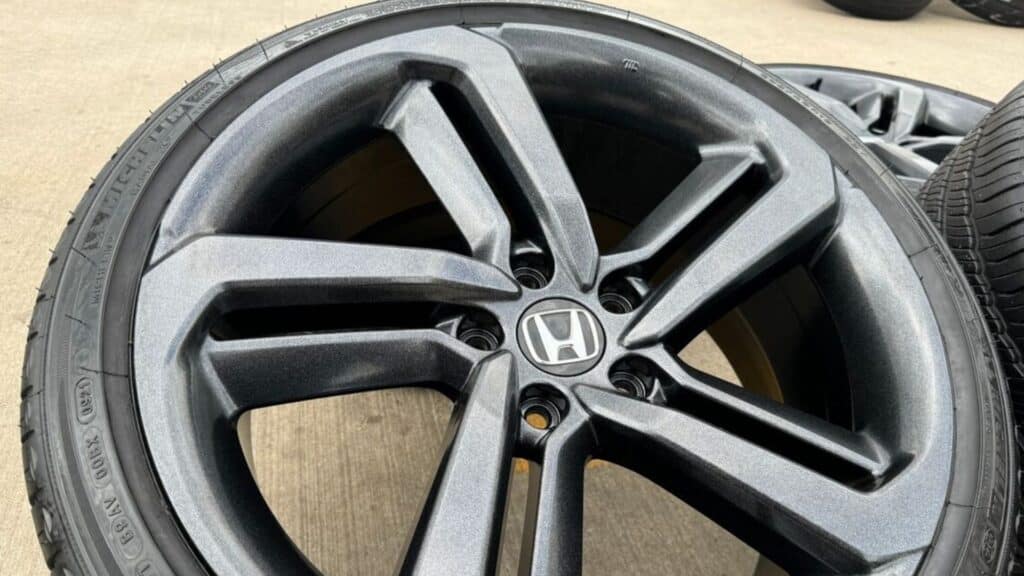Having trouble finding wheels for your Honda?
You’re not alone.
Bolt patterns tell you which wheels fit your car.
Knowing your car’s bolt pattern saves time and money for Honda owners and prevents buying the wrong wheels.
Here’s what you’ll learn:
- What Honda bolt patterns mean
- How to measure your bolt pattern correctly
- Which Honda models share the same patterns
- Common fitting mistakes to avoid
I’ve helped thousands of Honda owners find the right fit.
My guide draws on Honda’s technical documents and real mechanic knowledge.
It explains everything about Honda bolt patterns in simple terms and provides clear steps for following.
No more confusion about wheel compatibility – let’s get your Honda fitted with the right wheels.
What is the Bolt Pattern for a Honda?

Honda uses two main bolt patterns on their cars.
Let me break this down:
The most common Honda bolt pattern is 5×114.3mm. This means the wheel has five lug holes in a circle with a diameter of 114.3 mm.
You’ll find this pattern on most modern Honda cars and SUVs.
Some smaller Honda models use a 4x100mm pattern with four lug holes set in a 100mm circle.
Which pattern does your Honda have?
- 5×114.3mm: Accord, Pilot, CR-V, Odyssey
- 4x100mm: Older Civics, Fit, Jazz
A quick tip: Your owner’s manual lists your exact bolt pattern.
You can also look at your current wheels—the pattern is often stamped on them.
Why does this matter?
If you buy wheels with the wrong pattern, they won’t fit your car—it’s as simple as that.
Think of it like puzzle pieces—they need to match perfectly.
I suggest writing down your bolt pattern before shopping for new wheels.
This one step can save you from buying wheels that don’t fit.
Remember: The pattern must match exactly.
Even a tiny difference means the wheel won’t fit safely on your car.
Understanding Honda Bolt Patterns and Their Compatibility
Honda cars use specific bolt patterns that set them apart from other brands.
I’ll explain what makes them special and why getting the right match matters for your safety.
What Makes Honda Patterns Different?
Honda sticks to two main patterns across their lineup.
This keeps things simple when you want to swap wheels between Honda models.
But there’s more to think about than just the pattern.
Here’s what affects wheel compatibility:
- Center bore size
- Wheel offset
- Hub size
- Wheel width
- Tire size limits
Size and Vehicle Type Matter
Your Honda’s size and type affect which wheels fit.
A wheel that fits a Civic won’t necessarily work on a Pilot.
For example:
- Small cars (Civic, Fit): Need lighter wheels
- SUVs (CR-V, Pilot): Need stronger wheels
- Sports cars (Type R): Need wider wheels
Why Getting it Right Matters
Wrong wheel fitment can cause:
- Uneven tire wear
- Poor handling
- Brake problems
- Steering issues
- Extra stress on bearings
Safety Alert: Using wheels with the wrong patterns is dangerous.
Although they might seem to fit, they can come loose while driving.
Quick Compatibility Check
- Check your bolt pattern
- Measure your center bore
- Look up your wheel offset
- Confirm wheel width limits
I always tell Honda owners: don’t guess about compatibility.
One wrong measurement can lead to unsafe driving conditions.
When in doubt, ask a professional mechanic to check your wheel specs.
List of the Correct Bolt Pattern for Different Honda Models
I’ve compiled a complete list of Honda models and their bolt patterns.
Before checking the table, Note that some special editions might have different patterns.
When in doubt, check your owner’s manual.
Modern Honda Models (2010-2023)
| Model | Bolt Pattern | Center Bore |
|---|---|---|
| Accord | 5×114.3mm | 64.1mm |
| Civic (2012+) | 5×114.3mm | 64.1mm |
| CR-V | 5×114.3mm | 64.1mm |
| HR-V | 5×114.3mm | 64.1mm |
| Pilot | 5×114.3mm | 64.1mm |
| Odyssey | 5×114.3mm | 64.1mm |
| Fit | 4x100mm | 56.1mm |
Older Honda Models (Pre-2010)
| Model | Year Range | Bolt Pattern | Center Bore |
|---|---|---|---|
| Civic | 1990-2011 | 4x100mm | 56.1mm |
| Accord | 1990-2002 | 4×114.3mm | 64.1mm |
| Prelude | 1992-2001 | 5×114.3mm | 64.1mm |
| CRX | 1988-1991 | 4x100mm | 56.1mm |
| Del Sol | 1993-1997 | 4x100mm | 56.1mm |
Special Notes:
- Honda Type R models use the same patterns as their base models
- Some JDM (Japanese) models might have different patterns
- Always measure your bolt pattern if you own a modified Honda
How to Identify the Correct Bolt Pattern for a Specific Honda Model
Let me show you three simple ways to find your Honda’s bolt pattern.
Each method works well – pick the one that’s easiest for you.
Tools and Resources You’ll Need
- Measuring Tape or Ruler: Use one with millimeter markings for accuracy.
- Bolt Pattern Gauge: A simple tool you can buy online. It fits over the hub for quick readings.
- Owner’s Manual: Honda always lists the bolt pattern for your model.
- Online Resources: Websites like wheel-size.com have databases for most Honda models.
Method 1: Check Your Manual
Your owner’s manual lists the bolt pattern in the specifications section.
Look under “Wheels and Tires” or “Technical Data.”
Method 2: Measure It Yourself
Steps for 4-lug wheels:
- Find two holes across from each other
- Measure from center to center
- Write down the number in millimeters
Steps for 5-lug wheels:
- Find two holes farthest apart
- Measure from center to center
- Multiply your result by 1.051 for the true bolt circle
Method 3: Look at Your Current Wheels
Check the back of your wheel.
Many have numbers stamped on them, like “5×114.3.” That’s your bolt pattern.
Signs of Wrong Bolt Patterns:
- Wheels won’t sit flat against the hub
- Bolt holes don’t line up perfectly
- You need force to make holes match
- The wheel feels loose after tightening
Helpful Resources:
- Honda parts website
- Local Honda dealer
- Tire shops with wheel fitting tools
- Online wheel calculators
I recommend double-checking your measurements before buying new wheels.
One wrong number can cost you time and money.
Comparisons Between Honda’s and Other Brands’ Bolt Patterns
Let me show you how Honda’s bolt patterns compare to other car brands.
This helps when you’re looking at different wheel options.
Common Bolt Pattern Matches
Here’s a simple breakdown of which brands share Honda’s patterns:
| Brand | Common Pattern | Compatible With Honda? | Notes |
|---|---|---|---|
| Toyota | 5×114.3mm | Yes | Most modern models match |
| Nissan | 5×114.3mm | Yes | Check center bore size |
| Ford | 5×114.3mm | No | Different center bore |
| Hyundai | 5×114.3mm | Yes | Recent models only |
| Mazda | 5×114.3mm | Yes | Similar specs to Honda |
Note: Even with matching bolt patterns, wheels might not fit due to different center bores.
What This Means For You:
- You have more wheel options than you might think
- Some brands’ wheels cost less than Honda’s
- Aftermarket wheels often come with hub rings to fix center bore differences
How to Maintain Bolt Patterns on Your Honda
Good bolt maintenance helps your wheels stay secure.
I’ll show you how to keep everything in top shape.
Basic Maintenance Schedule
Check your wheel bolts every:
- 3 months for normal driving
- Month for heavy use
- The time you rotate tires
- Time you hit a big pothole
Cleaning Tips
Keep your bolts clean with these simple steps:
- Spray with brake cleaner
- Wipe with a clean cloth
- Check for rust or damage
- Apply a thin coat of anti-seize (on threads only)
Warning: Don’t use WD-40 on wheel bolts – it can affect torque values.
Correct Torque Settings
Most Honda models need:
- Sedans/Coupes: 80-85 ft-lbs
- SUVs/Vans: 85-95 ft-lbs
- Small cars: 75-80 ft-lbs
Tools You’ll Need
- Torque wrench ($40-80)
- Socket set ($30-50)
- Wire brush ($5)
- Brake cleaner ($8)
- Anti-seize compound ($6)
Signs You Need New Bolts
- Rust on threads
- Damaged threads
- Rounded edges
- Stretching or wear
Pro tip: Buy bolts from Honda or trusted brands. Cheap bolts can break under stress.
Quick Maintenance Steps
- Clean the bolts and holes
- Check for damage
- Use your torque wrench
- Mark the bolts with chalk after tightening
- Recheck torque after 50 miles
Bad bolts can make wheels come loose.
If you spot problems, fix them right away. Your safety depends on it.
Conclusion
Understanding your Honda’s bolt pattern keeps you safe and saves you money.
I hope this guide clarifies any confusion about wheel fitment.
Remember these key points:
- Check your exact pattern before buying wheels
- Maintain your wheel bolts regularly
- Use proper torque settings
- Buy quality parts
If you’re unsure about wheel compatibility, take your Honda to a professional.
It is better to spend a few minutes checking than risk your safety.
Need more help?
Comment below with your Honda model and year. I’ll help you find the right pattern and compatible wheels.
Keep your wheels secure, and enjoy the ride!
Frequently Asked Questions
Are Honda Bolt Patterns Universal?
No, Honda bolt patterns vary by model and vehicle type.
Always check your specific model’s requirements.
Can I Use Wheels from Another Brand on My Honda?
Yes, if the bolt pattern, offset, and center bore match your Honda’s specifications.
How Often Should I Inspect Bolt Patterns?
Inspect bolt patterns during tire rotations or at least every six months for rust, wear, or damage.
What Happens If I Use the Wrong Bolt Pattern?
The wrong bolt pattern can cause poor wheel fitment, vibrations, and potential safety hazards while driving.
Where Can I Find My Honda’s Bolt Pattern?
Check your Honda’s owner’s manual or inspect the wheel hub for specifications.


